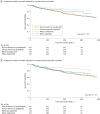Explaining Racial Disparities in Child Asthma Readmission Using a Causal Inference Approach
- PMID: 27182793
- PMCID: PMC5503118
- DOI: 10.1001/jamapediatrics.2016.0269
Explaining Racial Disparities in Child Asthma Readmission Using a Causal Inference Approach
Abstract
Importance: Childhood asthma is characterized by disparities in the experience of morbidity, including the risk for readmission to the hospital after an initial hospitalization. African American children have been shown to have more than 2 times the hazard of readmission when compared with their white counterparts.
Objective: To explain why African American children are at greater risk for asthma-related readmissions than white children.
Design, setting, and participants: This study was completed as part of the Greater Cincinnati Asthma Risks Study, a population-based, prospective, observational cohort. From August 2010 to October 2011, it enrolled 695 children, aged 1 to 16 years, admitted for asthma or wheezing who identified as African American (n = 441) or white (n = 254) in an inpatient setting of an urban, tertiary care children's hospital.
Main outcomes and measures: The main outcome was time to asthma-related readmission and race was the predictor. Biologic, environmental, disease management, access, and socioeconomic hardship variables were measured; their roles in understanding racial readmission disparities were conceptualized using a directed acyclic graphic. Inverse probability of treatment weighting balanced African American and white children with respect to key measured variables. Racial differences in readmission hazard were assessed using weighted Cox proportional hazards regression and Kaplan-Meier curves.
Results: The sample was 65% male (n = 450), and the median age was 5.4 years. African American children were 2.26 times more likely to be readmitted than white children (95% CI, 1.56-3.26). African American children significantly differed with respect to nearly every measured biologic, environmental, disease management, access, and socioeconomic hardship variable. Socioeconomic hardship variables explained 53% of the observed disparity (hazard ratio, 1.47; 95% CI, 1.05-2.05). The addition of biologic, environmental, disease management, and access variables resulted in 80% of the readmission disparity being explained. The difference between African American and white children with respect to readmission hazard no longer reached the level of significance (hazard ratio, 1.18; 95% CI, 0.87-1.60; Cox P = .30 and log-rank P = .39).
Conclusions and relevance: A total of 80% of the observed readmission disparity between African American and white children could be explained after statistically balancing available biologic, environmental, disease management, access to care, and socioeconomic and hardship variables across racial groups. Such a comprehensive, well-framed approach to exposures that are associated with morbidity is critical as we attempt to better understand and lessen persistent child asthma disparities.
Conflict of interest statement
Figures



Comment in
-
The "Black Box" of Racial Disparities in Asthma.JAMA Pediatr. 2016 Jul 1;170(7):644-5. doi: 10.1001/jamapediatrics.2016.0564. JAMA Pediatr. 2016. PMID: 27183533 No abstract available.
-
Artificially Sweetened Beverage Consumption During Pregnancy and Infant Body Mass Index.JAMA Pediatr. 2016 Nov 1;170(11):1116-1117. doi: 10.1001/jamapediatrics.2016.2813. JAMA Pediatr. 2016. PMID: 27669455 No abstract available.
References
-
- Gupta RS, Carrión-Carire V, Weiss KB. The widening black/white gap in asthma hospitalizations and mortality. J Allergy Clin Immunol. 2006;117(2):351–358. - PubMed
-
- Erickson SE, Iribarren C, Tolstykh IV, Blanc PD, Eisner MD. Effect of race on asthma management and outcomes in a large, integrated managed care organization. Arch Intern Med. 2007;167(17):1846–1852. - PubMed
Publication types
MeSH terms
Grants and funding
LinkOut - more resources
Full Text Sources
Other Literature Sources
Medical

